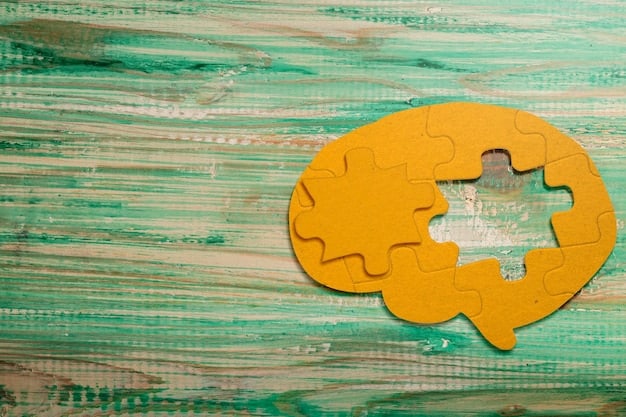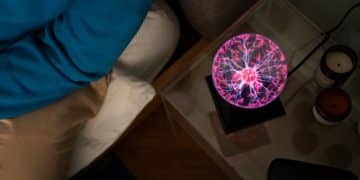Time Off is Productive: Strategic Breaks for 20% Focus Boost

Taking strategic breaks and time off isn’t just about rest; it’s a productivity multiplier, potentially boosting your focus and effectiveness by up to 20% through improved mental clarity and reduced burnout.
In today’s fast-paced work environment, it’s easy to fall into the trap of believing that constant work equals high productivity. However, research increasingly suggests that the opposite is true. Embracing the concept that time off is productive: how strategic breaks can boost focus by 20% is essential for sustained performance and overall well-being.
The Science Behind Strategic Breaks
Understanding why breaks are beneficial requires a look at the science behind how our brains function under stress and prolonged focus. Continuous work without respite can lead to cognitive fatigue, diminishing our ability to concentrate and solve problems effectively.
Cognitive Fatigue and the Brain
Cognitive fatigue occurs when our brains are forced to maintain focus for extended periods. This can lead to decreased attention spans, increased errors, and a general feeling of mental exhaustion. Regular breaks help to alleviate this fatigue.
The Role of the Default Mode Network (DMN)
The Default Mode Network (DMN) is a brain network that becomes active when we are not focused on a specific task. It allows us to engage in introspection, creative thinking, and memory consolidation. Strategic breaks provide the opportunity for the DMN to activate, leading to improved cognitive function.
- Breaks help reset your mental state, preventing burnout.
- Stepping away allows your brain to consolidate information.
- Strategic pauses boost creative thinking and problem-solving skills.
- Regular interruptions enhance long-term focus and productivity.
By understanding the scientific basis for strategic breaks, we can begin to appreciate their value in enhancing productivity and overall cognitive health. Incorporating these breaks into our daily routines is not merely an indulgence, but a strategic necessity for optimal performance.

Planning Your Time Off: Micro-Breaks and Macro-Breaks
Effective time management includes not only when to work but also when to disengage. Planning your time off involves understanding the difference between micro-breaks and macro-breaks and how to incorporate them strategically into your schedule. This balance ensures that you remain productive while preventing exhaustion.
Micro-Breaks: Short Bursts of Relaxation
Micro-breaks are short, frequent pauses taken throughout the workday. These can be as simple as standing up to stretch, grabbing a glass of water, or taking a few deep breaths. The goal is to provide immediate relief from mental strain.
Macro-Breaks: Extended Periods of Disconnection
Macro-breaks involve a more significant amount of time away from work, such as a lunch break, an afternoon off, or a vacation. These extended periods allow for deeper relaxation and recovery, preventing cumulative stress and burnout.
- Schedule micro-breaks every 25-30 minutes to maintain focus (Pomodoro Technique).
- Take a longer lunch break to fully disconnect and recharge.
- Plan regular vacations to completely step away from work demands.
- Use weekends to pursue hobbies and interests outside of work.
Strategic planning of both micro and macro-breaks is crucial for maintaining a healthy work-life balance and enhancing long-term productivity. By intentionally integrating these breaks, you provide your mind with the necessary space to recover and rejuvenate, ultimately leading to more effective and focused work sessions.
The Pomodoro Technique: A Practical Approach
One effective method for integrating strategic breaks is the Pomodoro Technique, a time management system that encourages focused work sessions interspersed with short breaks. This technique can help you maintain concentration and avoid burnout.
How the Pomodoro Technique Works
The Pomodoro Technique involves working in focused 25-minute intervals (called “pomodoros”) followed by a 5-minute break. After every four pomodoros, take a longer break of 20-30 minutes. This structured approach helps to balance work and rest.
Benefits of Using the Pomodoro Technique
The Pomodoro Technique offers several benefits, including improved focus, enhanced productivity, and reduced mental fatigue. It also encourages better time estimation and task management.
Implementing the Pomodoro Technique
To implement the Pomodoro Technique, start by identifying the tasks you want to accomplish. Break down large tasks into smaller, manageable chunks, and then work on each task for 25 minutes. Use a timer to ensure you stick to the intervals.
- Set a clear goal for each 25-minute work interval.
- Eliminate distractions during work periods.
- Use the 5-minute breaks to stretch, hydrate, or clear your mind.
- Track your pomodoros to monitor your progress and performance.
By integrating the Pomodoro Technique into your daily routine, you can create a sustainable rhythm of focused work and strategic breaks, ultimately boosting your overall productivity and well-being. This method provides a practical framework for managing time and energy effectively.

Beyond the Clock: Mindful Breaks and Mental Reset
While structured techniques like the Pomodoro method are valuable, incorporating mindful breaks offers a complementary approach to enhance mental clarity and productivity. Mindful breaks prioritize mental and emotional well-being, promoting a deeper sense of calm and focus.
What are Mindful Breaks?
Mindful breaks involve intentionally focusing on the present moment without judgment. This can include activities such as meditation, deep breathing exercises, or simply observing your surroundings with a sense of curiosity.
Benefits of Mindfulness
Mindfulness practices have been shown to reduce stress, improve concentration, and enhance emotional regulation. By incorporating mindfulness into your breaks, you can create a mental reset that prepares you for more effective work.
Incorporating Mindfulness into Your Breaks
Start by setting aside a few minutes each day to practice mindfulness. Find a quiet space where you can sit comfortably and focus on your breath. Pay attention to your thoughts and emotions without getting carried away by them.
- Practice deep breathing exercises to calm your nervous system.
- Engage in a short meditation to clear your mind.
- Take a walk in nature, paying attention to the sights, sounds, and smells around you.
- Practice gratitude by focusing on the things you appreciate in your life.
By integrating mindful breaks into your routine, you can cultivate a greater sense of awareness and presence, allowing you to approach your work with renewed energy and focus. This holistic approach to time management emphasizes the importance of mental and emotional well-being in achieving optimal productivity.
Creating a Supportive Environment
The effectiveness of strategic breaks isn’t solely dependent on individual practices; it also relies on the environment in which you work. Cultivating a supportive environment that encourages and facilitates breaks is crucial for maximizing their benefits.
Encouraging Breaks in the Workplace
Creating a culture that values breaks starts with leadership. Managers and team leaders should model healthy break-taking habits and encourage employees to prioritize their well-being. Normalize the idea of stepping away from work to recharge.
Designing Break-Friendly Spaces
The physical environment also plays a significant role. Designate spaces specifically for breaks, equipped with comfortable seating, natural light, and amenities like coffee and tea. These spaces should be inviting and conducive to relaxation.
Tools and Technologies for Break Management
Utilize tools and technologies that support break management. There are various apps and software programs designed to remind you to take breaks and track your progress. These tools can help you stay consistent with your break schedule.
- Encourage short breaks during meetings to prevent cognitive fatigue.
- Create dedicated break rooms with comfortable seating and calming decor.
- Use apps and software to schedule and track breaks throughout the day.
- Promote walking meetings to combine physical activity with work discussions.
By fostering a workplace culture that values and supports breaks, you can create an environment where employees feel empowered to prioritize their well-being. This leads to increased job satisfaction, reduced burnout, and enhanced overall productivity. A supportive environment reinforces the understanding that taking time off is not a sign of weakness, but a strategic approach to maximizing performance.
Measuring the Impact: Tracking Productivity and Well-being
To truly understand the benefits of strategic breaks, it’s essential to measure their impact on both productivity and well-being. Tracking these metrics provides tangible evidence of their effectiveness and helps refine your approach over time.
Setting Measurable Goals
Start by setting specific, measurable, achievable, relevant, and time-bound (SMART) goals related to your productivity and well-being. These goals should be aligned with the implementation of strategic breaks.
Using Productivity Tracking Tools
Utilize productivity tracking tools to monitor your output and efficiency. These tools can provide insights into how breaks influence your ability to complete tasks, manage time, and maintain focus. Compare your performance before and after implementing strategic breaks.
Assessing Well-being
Assess your well-being through regular self-assessments and feedback. Pay attention to your stress levels, energy levels, and overall mood. Consider using standardized questionnaires to track your mental and emotional health.
- Track your task completion rate and error rate before and after implementing breaks.
- Monitor your energy levels and mood throughout the day.
- Use surveys and questionnaires to assess your stress levels and job satisfaction.
- Solicit feedback from colleagues and supervisors regarding your performance and well-being.
By consistently measuring the impact of strategic breaks on both productivity and well-being, you can gain a deeper understanding of their value. This data-driven approach allows you to refine your break schedule and maximize their benefits, ensuring a sustainable and effective work routine. Objective measurement reinforces the understanding that time off is an investment in long-term performance and personal health.
| Key Point | Brief Description |
|---|---|
| ⏱️ Pomodoro Technique | Work in 25-minute intervals followed by a 5-minute break to boost focus. |
| 🧘 Mindful Breaks | Incorporate meditation and deep breathing to reduce stress and enhance mental clarity. |
| 🏢 Supportive Environment | Encourage breaks in the workplace and design break-friendly spaces to maximize well-being. |
| 📊 Track Impact | Measure productivity and well-being to understand the benefits of strategic breaks. |
FAQ
▼
Strategic breaks help to combat cognitive fatigue, allowing your brain to reset and consolidate information. They enhance focus, boost creativity, and prevent burnout, leading to sustained productivity gains.
▼
It’s generally recommended to take a micro-break every 25-30 minutes. These short pauses can involve stretching, hydrating, or simply looking away from your screen to refresh your eyes and mind.
▼
Effective mindfulness techniques include deep breathing exercises, short meditations, and mindful walks in nature. Focusing on the present moment can help reduce stress and improve concentration for better productivity.
▼
Companies can encourage break-taking by normalizing the practice, creating dedicated break spaces, and utilizing tools that remind employees to take breaks. Leadership modeling healthy behaviors can significantly influence workplace culture positively.
▼
Track your task completion, error rates, energy levels, and mood. Surveys and tools can assess stress levels and job satisfaction. Comparing these metrics before and after implementing strategic breaks provides insights into their effectiveness.
Conclusion
Embracing strategic breaks and understanding that time off is productive is essential for sustained focus and overall well-being. By incorporating techniques like the Pomodoro method, mindful breaks, and creating a supportive environment, you can unlock a potential 20% boost in productivity and mental clarity, leading to a more effective and balanced work life.





